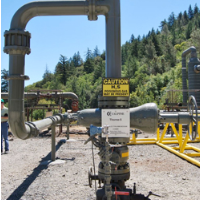12 More Wells Closed for Pumping Wastewater into Aquifers
 Fracking waste injection well (photo: Flickr-kqedquest)
Fracking waste injection well (photo: Flickr-kqedquest)
“Look and you will find it—what is unsought will go undetected.”
Sophocles
It doesn’t take a Greek philosopher to figure out that if no one asked oil companies if they were drilling injection wells and pumping toxic chemicals into otherwise clean aquifers, the activity would go undetected. After decades of drilling, amplified by new technological extraction processes like hydraulic fracturing (fracking), people are starting to look.
On Tuesday, state regulators asked oil companies to shut down 10 wells and served cease-and-desist orders for two others over the poor choice of drilling locations in the Central Valley. Eight other wells were shut down last year after media reports highlighted the broader problem of unregulated drilling, and heightened oversight mandated by the state’s first fracking legislation, Senate Bill 4, began to kick in.
Poisoning aquifers also became a concern after three years of drought exacerbated California’s chronic water shortage problems. Drilling wastewater can contain arsenic, benzene, heavy metals and radioactive material.
California has around 50,000 injection wells, which take the enormous amounts of wastewater used to drill oil and gas wells and stick it back in the ground. Much of that happens in Kern County, home to 80% of the state’s drilling. The state has determined that 2,553 of the wells are near aquifers and 176 may be problematic.
In response to prodding by the U.S. Environmental Protection Agency (EPA), the state finally started a survey of existing injection wells in 2011. In a February report (pdf) on how it’s doing, state regulators admitted approving drilling projects in zones that impact good aquifers.
“The Division has been slow to reconcile the reality that industry has expanded the productive limits of oil fields,” the report said, chastising one of its authors, the state Department of Conservation’s Division of Oil, Gas & Geothermal Resources (DOGGR), for not reacting to the popularity of high-impact drilling techniques like fracking.
Now that the Division knows that pumping millions of gallons of wastewater into aquifers is a bad thing, “a process has been developed to determine the wells with the highest risks associated with injection, and the steps to be taken to bring injection well permits into compliance.”
The survey covers 30,000 wells. “When completed, this review will serve to clarify records and improve data quality so that the full review of the UIC program can be completed.” That would be by May 15 of this year. The EPA ordered the state to comply fully with federal regulations by February 2017.
The state will continue to shut down wells as deemed necessary while the review proceeds and will expand testing of aquifers to see if they have been impacted. The fact that some wells have already been closed “does not necessarily mean that the aquifers have been spoiled,” DOGGR Supervisor Steve Bohlen told the Associated Press.
But we won’t know for sure until we look.
–Ken Broder
To Learn More:
California Shuts Down Oil Wells to Protect Groundwater (by Scott Smith, Associated Press)
California Orders Oil Companies to Stop Drilling near Drinking Water Supplies (by Ari Phillips, ThinkProgress)
State Shuts 12 Oil Company Wells That Pumped Waste into Aquifers (by David R. Baker, San Francisco Chronicle)
California Orders 12 Oil-Field Wells Shut to Protect Groundwater (by Chris Megerian, Los Angeles Times)
State Shuts Down Fracking Waste Injection Sites as Possible Threats to Aquifers (by Ken Broder, AllGov California)
- Top Stories
- Controversies
- Where is the Money Going?
- California and the Nation
- Appointments and Resignations
- Unusual News
- Latest News
- California Forbids U.S. Immigration Agents from Pretending to be Police
- California Lawmakers Urged to Strip “Self-Dealing” Tax Board of Its Duties
- Big Oil’s Grip on California
- Santa Cruz Police See Homeland Security Betrayal in Use of Gang Roundup as Cover for Immigration Raid
- Oil Companies Face Deadline to Stop Polluting California Groundwater





